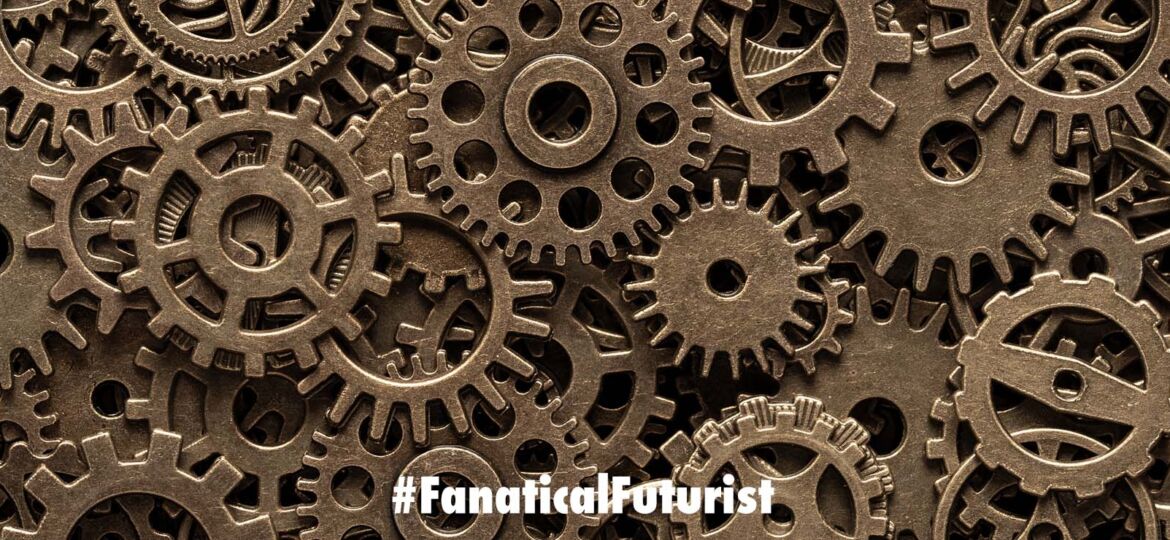
WHY THIS MATTERS IN BRIEF
3D printing’s ultimate dream is to be able to print working products straight off the printer that don’t need to be assembled by humans or robots, this is the first step.
 Love the Exponential Future? Join our XPotential Community, future proof yourself with courses from XPotential University, read about exponential tech and trends, connect, watch a keynote, or browse my blog.
Love the Exponential Future? Join our XPotential Community, future proof yourself with courses from XPotential University, read about exponential tech and trends, connect, watch a keynote, or browse my blog.
3D printing has been around for decades and it’s now reached the point where companies are using it to print everything from buildings, cars, and rockets, to weapons and even human hearts. But despite these advances noone up until now has been able to 3D print machines that work straight off the printer without needing to be assembled first.
By shining light beams in liquid resin researchers have managed to create an entirely new 3D printing technique, dubbed “Xolography,” that can generate complex hollow structures – including simple machines with moving parts. And that’s the interesting part.
“I like to imagine that it’s like the replicator from Star Trek,” says study co-author Martin Regehly, an experimental physicist at the Brandenburg University in Germany. “As you see the light sheet moving, you can see something created from nothing.”
Conventional 3D printing creates items layer by layer. However, this approach runs into problems when printing hollow objects since overhanging features will naturally collapse without anything supporting them from underneath.
So far a number of methods have tried to solve this problem by 3D printing hollow structures by shining laser light at vats of liquid resin that then solidify to form complex shapes suspended in photo-reactive resin. In these so called volumetric techniques, that Adidas use for example to print trainers, the light solidifies any liquid it shines on, while the rest of the resin provides support that keeps the hardened material from collapsing.

Courtesy: Xolo3D
Now, thanks to their new technique the team in Germany can 3D print objects at significantly greater speeds and higher resolutions than previous volumetric techniques and their research has been published in Nattured. They’ve also developed a startup dubbed Xolo to commercialize their work.
The new technique uses two kinds of light to print. First, a rectangular sheet of ultraviolet light excites a thin layer of special molecules within the resin from an initial dormant state to a latent state. Next, an image of a slice of the printed object is projected onto this sheet using white light, hardening only the activated resin.
“Xolography” refers to how crossing (“X”) light beams can generate entire (“holos”) objects in this printing (“graphia”) technique.
Using xolography, the researchers could generate free-floating objects without any support structures, such as simple machines with wheels inside that can spin in response to flowing liquid, or a ball in a spherical cage. They also printed out a highly detailed 3-centimeter-wide bust of a person with precisely defined internal anatomical features, such as a hollowed-out nasal passage and esophagus. Currently xolography can print at rates of about 55 cubic millimeters per second with structures as small as 25 microns wide.
One previous volumetric technique, known as two-photon photopolymerization, can generate features smaller than 100 nanometers in size, but is slow because patches of the resin used in this method only solidify when they absorb two photons of light at the same time. Another, known as computed axial lithography, is much faster than two-photon photopolymerization, but is limited to producing features roughly 300 microns large, as resin hardening in one spot can interfere with light rays as they seek to solidify resin in other areas.
Xolography is up to 100,000 times faster than two-photon photopolymerization and roughly as fast as computed axial lithography because it does not rely on each target spot absorbing two photons at once.
“It’s extremely unlikely that two photons will hit a molecule at the same time,” Regelhy says. “So two-photon photopolymerization can take a long time.”
In addition, xolography can achieve resolutions roughly 10 times higher than computed axial lithography because it can rapidly and selectively harden only the activated resin and not the rest of the material.
“We never have to transmit light through already written stuff,” says study co-author Stefan Hecht, a chemist and materials scientist at Aachen University in Germany. “It’s the same as preferring to write on an empty page of paper than on an old page with writing already on it.”
One possible major application for xolography is generating complex biological structures, such as human organs and tissues, using fluids laden with living cells. Hecht notes the advantage that xolography would have over existing bioprinting techniques is that the cells would not experience the stress they would from getting sprayed out a bioprinter nozzle, which could damage them.
“On the other hand, we can also print extremely hard stuff — we can print glass,” Hecht adds. “We can work with an amazing versatility of materials.”
The researchers suggest they could speed up xolography’s printing rate by using more powerful lasers and by tinkering with their resin. In addition, they suggest they could use more complex resins to print multiple kinds of materials at the same time in order to produce devices such as sensors and electronics, Regelhy says.
Future research will explore how to get out any resin still remaining within printed items, Regelhy says. “This also raises the question of whether it is possible to reuse the liquid,” he notes.
















